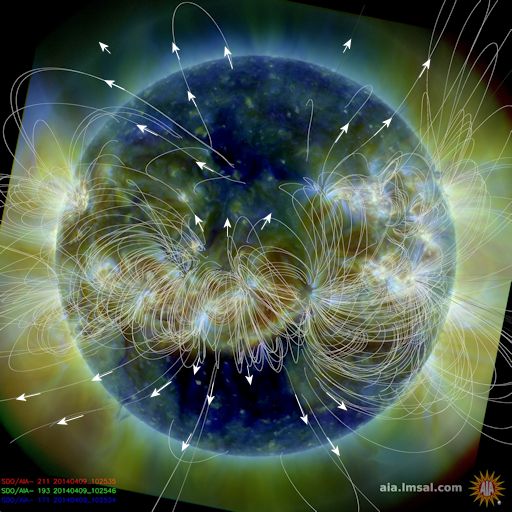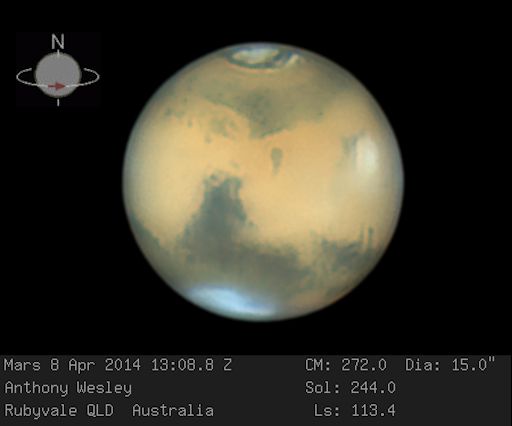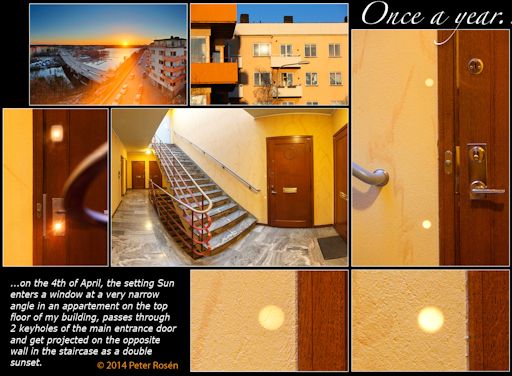On April 15th there will be a total eclipse of the Moon. Got clouds? No problem. The event will be broadcast live on the web by the Coca-Cola Science Center. | | |
QUIET SUN: Solar activity was very low yesterday, and the quiet appears set to continue today. NOAA forecasters put the odds of an X-flare on April 9th at no more than 1%. Solar flare alerts: text, voice
CORONAL HOLES: NASA's Solar Dynamics Observatory is monitoring a pair of coronal holes straddling the sun's equator. They are the deep-blue wedges in this extreme ultraviolet image of the sun taken mid-day on April 9th:

Coronal holes are places in the sun's atmosphere where the ambient magnetic field opens up and allows solar wind to escape. A double-stream of solar wind flowing from these coronal holes could reach Earth on April 13-14. It is possible that neither stream will be geoeffective as they flow north and south of our planet. On the other hand, a "brush pass" might still spark polar auroras. Stay tuned for updates. Aurora alerts: text, voice
CLOSE ENCOUNTER WITH MARS: In only 5 days, Mars will make its closest approach to Earth since 2012. Australian astrophotograher Anthony Wesley couldn't wait. Using a 16 inch telescope, he took this picture last night:

His high-reolution image shows the rapidly evaporating north polar cap (summer began there in February),
orographic clouds over the
Elysium volcanoes near the Martian equator, and an even brighter blue cloud over the
Hellas impact basin in the southern hemisphere. Hellas is the lowest point on Mars, and some of the haze evident there could be icy fog.
Getting such Hubblesque results from a 16-inch telescope requires a combination of good seeing and long years of experience. Wesley is one of the world's top amateur astrophotographers and he routinely produces images like this. Observers with less experience can take good photos, too, especially in the nights ahead as Mars nears Earth.
Look for burnt-orange Mars rising in the east around around 10 p.m. about 5° from the blue 1st-magnitude star Spica. For more information about what you can expect to see, click here.
Realtime Mars Photo Gallery
MINI-STONEHENGE DISCOVERED IN STOCKHOLM: "A year ago, I was standing in the staircase on the top floor of my apartment building talking to a neighbor," recalls Peter Rosén of Stockholm, Sweden. "Suddenly he noticed a perfect image of the Sun slowly moving across the wall behind me. The Sun was shining through a keyhole which acted as a lens, just like a gigantic pinhole camera. It only lasted for a couple of minutes."
Rosén is a photographer, and he wanted to record the phenomenon. "Unfortunately I had not taken note of the exact date and time. So, this spring, I have been waiting for days with my camera ready on a tripod." Finally, on April 4th, the alignment occurred:

"When the Sun finally appeared on the 4th of April, there was not one but two perfect tiny Suns, slowly moving across the opposite wall," says Rosén. "Our building is perfectly oriented to the cardinal points so theoretically it could have occured on the spring equinox, but as the windows are slightly offset, we have to wait for 2 more weeks before getting this perfect alignment."
"But it still is like having a miniature Stonehenge at home!"
Extra: Reader Tom O'Brian offers an additional perspective on the 'Stockholm Stonehenge': "A better comparison might be that of Newgrange in Ireland, where the Neolithic tomb entrance perfectly aligns with the moment of sunrise at the winter solstice each year. Newgrange is older than the pyramids and than Stonehenge. Because of the variability of Irish weather, sunlight floods the tomb on only about one year in five. So its builders, all those thousands of years ago, would on average have needed to wait five years between alignments even at the building stage of their monument and thereafter to observe the solstice."
Realtime Space Weather Photo Gallery
Realtime Comet Photo Gallery
Realtime Aurora Photo Gallery
Every night, a network of NASA all-sky cameras scans the skies above the United States for meteoritic fireballs. Automated software maintained by NASA's Meteoroid Environment Office calculates their orbits, velocity, penetration depth in Earth's atmosphere and many other characteristics. Daily results are presented here on Spaceweather.com.
On Apr. 7, 2014, the network reported 41 fireballs.
(41 sporadics)

In this diagram of the inner solar system, all of the fireball orbits intersect at a single point--Earth. The orbits are color-coded by velocity, from slow (red) to fast (blue). [Larger image] [movies]
Potentially Hazardous Asteroids (
PHAs) are space rocks larger than approximately 100m that can come closer to Earth than 0.05 AU. None of the known PHAs is on a collision course with our planet, although astronomers are finding
new ones all the time.
On April 9, 2014 there were 1465 potentially hazardous asteroids.
Notes: LD means "Lunar Distance." 1 LD = 384,401 km, the distance between Earth and the Moon. 1 LD also equals 0.00256 AU. MAG is the visual magnitude of the asteroid on the date of closest approach. | | The official U.S. government space weather bureau |
| | The first place to look for information about sundogs, pillars, rainbows and related phenomena. |
| | Researchers call it a "Hubble for the sun." SDO is the most advanced solar observatory ever. |
| | 3D views of the sun from NASA's Solar and Terrestrial Relations Observatory |
| | Realtime and archival images of the Sun from SOHO. |
| | from the NOAA Space Environment Center |
| | the underlying science of space weather |

